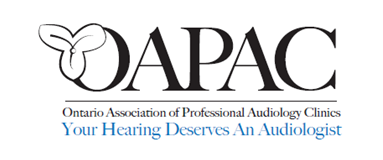YOU DESERVE TO BE HEARD
ADVOCATING FOR
ONTARIO’S AUDIOLOGISTS
ONTARIO’S AUDIOLOGISTS
Speaking up for professional Audiology clinics!
Advocacy
OAPAC is committed to ongoing advocacy work on behalf of its members and the Audiology profession. This advocacy includes working with key political stakeholders in the provincial government to advance the goals of OAPAC and protect the health and well-being of Ontarians. OAPAC has spent over three decades trying to effectuate changes that would save the government money while preserving and improving quality of hearing care for Ontarians, and continues to do so diligently.
and the Audiology profession. This advocacy includes working with key political stakeholders in the provincial government to advance the goals of OAPAC and protect the health and well-being of Ontarians. OAPAC has spent over three decades trying to effectuate changes that would save the government money while preserving and improving quality of hearing care for Ontarians, and continues to do so diligently.
All of our advocacy work is conducted in line with our organizational mission: to grow, expand and foster Audiologist-owned clinics across Ontario, offering local, safe, regulated services for hearing and balance.
Currently, OAPAC is focused on fostering change in two key areas. We are recommending that the Ontario Government:
- Support fair access to diagnostic imaging by authorizing Audiologists to order clinically appropriate imaging tests.
- Issue ID Practitioner Numbers to Audiologists to allow Audiologists to refer patients directly to ENT Surgeons when medically necessary.
Support fair access to diagnostic imaging by authorizing Audiologists to order clinically appropriate imaging tests.
Ontario Government Consultation: Expanding the Scope of Practice for Regulated Health Professionals
Instructions for Audiologists to take part in Government of Ontario Scope of Practice consultations
Background:
The provincial government is consulting with Ontarians and stakeholder as they consider potential scope of practice expansions to authorize dental hygienists, denturists, speech-language pathologists, physiotherapists, chiropractors, and chiropodists to order certain diagnostic imaging tests. Unfortunately, the list of health professionals under consideration does not currently include audiologists.
You can find more information on the consultation here: Consultation on proposed changes to scopes of practice for several regulated health professions to support greater access to diagnostic imaging. | regulatoryregistry.gov.on.ca
OAPAC’s Government Relations Committee will be taking part in the consultation with a formal written submission to urge the government to include audiologists in the group of health professionals authorized to order diagnostic imaging tests like CT scans, MRI scans, and X-rays for patients.
Our Ask to Members:
OAPAC members are invited and encouraged to contribute to the Ministry of Health’s consultation by submitting individual letters. Members can refer to the key messages provided below as guidance to develop their own personalized responses based on personal experience, rather than copying these messages directly.
Key Messages for Audiologists’ Letters to the Ministry of Health:
With the ability to order diagnostic tests, audiologists can provide more timely and accurate diagnoses by specialists, leading to earlier interventions and improved health outcomes for patients experiencing hearing loss and related conditions.
1. Patient Access and Timely Care: The average wait time to see an ENT specialist in Ontario is currently 142 days on average, which significantly delays diagnosis and treatment for individuals with hearing and related health concerns. Allowing audiologists to directly order diagnostic tests would allow serious conditions to be handled earlier and streamline access to care for thousands of Ontarians.
2. Expertise and Training: Audiologists are highly trained professionals, with over six years of training, specializing in the assessment and management of hearing loss and vestibular disorders. Their expertise positions them to recognize when advanced diagnostic tests, such as MRI, CT scans, or X-rays, are clinically warranted.
3. Improved hearing disorders management: An MRI is currently the gold standard in helping Audiologists with better decision-making in the treatment of hearing loss and disorders. These technological advances not only improve diagnostic accuracy but also have deep implications for personalized medicine in ear health.
4. Improved Use of Health Care Resources: Ontario’s health-care system operates on a referral-based model to manage patient flow and resources. Empowering audiologists to order tests and identify red flags directly would help reduce unnecessary referrals, optimize specialist waitlists, and alleviate pressure on primary care physicians and ENT specialists.
5. Consistency with other Regulated Health Professionals: Audiologists have the skills and knowledge necessary to join other health professionals in ordering diagnostic imaging tests. Expansion of scope of practice to other health professionals such as dental hygienists, denturists, speech-language pathologists, physiotherapists, chiropractors, and chiropodists is commendable but should also be extended to audiologists, ensuring fair and consistent recognition across disciplines and minimizing confusion for patients.
In order to submit your messages to the Government in Ontario’s consultation process, please use the following steps:
1. Visit the official consultation website here: Submit Comment | regulatoryregistry.gov.on.ca
2. Select “Submit as a Guest” at the bottom of the page
3. Select: “I am submitting as a member of the public”
4. Enter your email address and cut and paste your comments into the box provided or upload your letter by following the instructions
5. After completing the form, click “Submit”
Thank You and Next Steps:
OAPAC’s Government Relations Committee thanks you for your contribution to this effort. OAPAC will follow-up with requests to meet with government officials and others to ensure audiologists are authorized with scope of practice enhancements that leverage their skills and enable them to treat their patients effectively.
Issue ID Practitioner Numbers to Audiologists to allow Audiologists to refer patients directly to ENT Surgeons when medically necessary.
Background:
Audiologists are qualified and well-positioned to directly refer patients to otolaryngologist (ENTs).
ENTs, or otolaryngologists, are physicians and surgeons who specialize in treating the interrelated systems of the ears, nose, sinuses, and throat. Audiologists and ENTs often work closely together to complete care. When a patient’s hearing loss has an organic or physical cause, for example, the Audiologist may recommend seeing an ENT for corrective treatment.
In order to do so, however, a patient must first receive a referral from a family physician.
This requirement for a referral from a family physician poses several problems. While referrals from non-physicians might be permitted by the Specialist, according to OHIP rules, when a non-physician practitioner requests the opinion of a physician or requests the transfer of care of a patient to a physician, the service provided by the physician in such circumstances cannot be claimed to OHIP as a consultation (OHIP Bulletin 4318, page 2). The service claimed must therefore be a lower assessment fee — specialists are thus compensated for less, which acts as a deterrence.
Referral to a family physician unnecessarily wastes OHIP dollars. This process requires OHIP to be billed three separate times:
- When the patient sees their Audiologist.
- When the patient sees their family physician.
- When the patient sees their ENT.
The process ties up the time of additional health professionals, unnecessarily increasing wait times to see a family physician. Some patients seen by Audiologists lack a family doctor physician altogether and therefore cannot be referred to an ENT if needed, creating a clear barrier to critical care. (2 million people lack a family physician.)
The solution to these problems is clear: facilitate Audiologists to directly refer patients to ENTs by issuing a referral number.
This practice is already in place in Alberta and the benefits of its implementation are evident.
Benefits:
Direct referral enables the Audiologist to see the patient directly, triage that patient, and refer to the ENT only as needed. This reduces the number of OHIP billing instances and ensures patients receive quick and effective Audiological treatment. In fact, a one-year study of patients with hearing problems, found that 95% of patients only required Audiological treatment, foregoing the need for an additional reference to an ENT. This is supported by many other studies, such as one featured in the Journal of the American Academy of Audiology, 21(6), 2010.
Direct referral to an ENT will provide significant cost savings to OHIP by limiting unnecessary billing instances. Literally millions of dollars could be saved annually.
Issuing ID Practitioner Numbers to Audiologists will allow Audiologists to refer patients directly to ENT Surgeons when medically necessary, saving Ontario valuable dollars and Ontarians lengthy wait-times for critical care.

